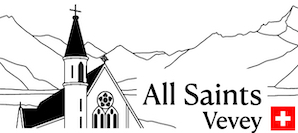History
The congregation of All Saints was established in 1882. The Church building was designed by an English architect by the name of George Street, who was in fact quite a notable architect towards the end of the 19th century, particularly concerning churches which were his specialty. He also designed the English Church in Lausanne.
Although the church building was not built until 1882, there are written records which confirm that English Church services were held in this area from 1823 onwards. It should be remembered that from the beginning of the 19th century this end of the Lake of Geneva became increasingly popular with English and Americans, both residents and visitors, and there has been for almost two centuries a strong English-speaking population in the Vevey-Montreux area.
It’s somewhat surprising that the English speaking community was able to hold services, to worship and to pray together for 60 years without having churches of their own – but once they got started on building there was no holding them back: Lausanne and Montreux in 1878, Vevey in 1882, a second church in Montreux in 1888.
During those 60 years, services in the Vevey area were held in various locations, certainly in people’s homes, at the Swiss Church in La Tour-de-Peilz, at St. Martin’s Church in Vevey and also at Ste. Claire’s Church in Vevey, just a few hundred yards from here. St Claire’s is the Church that we were able to use for almost a year while the building of the new Hall was under way, so it really was a retour aux sources.
In 1844, forty years before the church was built, a Chaplain was appointed to look after the growing congregation in Vevey. His name was the Rev. O’Meary Dean. In 1845 he replied at some length to a questionnaire that was addressed to him by Church authorities in London and the knowledge that we have of those early years in the Chaplaincy comes largely from what he wrote in the questionnaire.
These wanderings from one place of worship to another came to an end in Vevey in 1882. The new Church was consecrated, rather surprisingly, by Bishop Stevens of Pennsylvania. This might have led, in fact, to a report written thirty years later which mentions that “The Church has always been well attended and well supported by Americans” – and, indeed, it still is.
And then there is a quite a long gap when nobody recorded very much about what went on, though we do have the names and dates of the various chaplains who have served here – one can only assume that church life went on without too much upset, and they didn’t have a Building Project under way.
The early years of the 1950s were difficult times. A strong devaluation of the pound brought about the departure of a considerable number of parishioners, and the financial situation of the church was so bad that the council had to ask the Chaplain to leave as there was not enough money to pay his salary! There was another devaluation 20 years later, but we managed then to keep the Chaplain and most of the congregation.
Recent highlights in All Saints’ include the construction of the first Church Hall, in 1977 when Richard Thompson was Chaplain, allowing the organisation of regular mid-week activities. Not many weeks went by before everyone was asking how we’d managed for almost a hundred years without the hall! Perhaps the most important blessing that it brought was the immediate expansion of our work with young children through Sunday school classes and youth groups, both of which already existed but were rather cramped.
It was in fact Joyce Wailes, who served the church faithfully, who began teaching Sunday School classes towards the end of the 1960s. And so, the end of the 1970s and early 1980’s saw an influx of families with young children into the church and this step forward has been encouraged and maintained by all the Chaplains since then: Tim Barlow, David Ritchie, Derek Frank and Clive Atkinson.
In 1982 we celebrated the centenary of the church with the former Archbishop of Canterbury, Lord Coggan, officiating. In 2001 further excavation took place beneath the Church which led to the doubling of the space that had served us so well during the previous 25 years. We now have even better facilities for continuing the work of the church as well as for social activities, monthly lunches, not to mention art classes, Little Arrows, Welcome evenings and many other good works.
In conclusion we should mention that our patrons are the Intercontinental Church Society – an Anglican mission society which seeks to make known the Good News of Jesus Christ to people who speak English, though churches and other places of worship in many countries throughout Europe and North Africa.
We are part of the Archdeaconry of Switzerland, consisting of seven permanent Anglican chaplaincies – in Geneva, Lausanne, Montreux, Berne, Basel, Zurich and Vevey.
